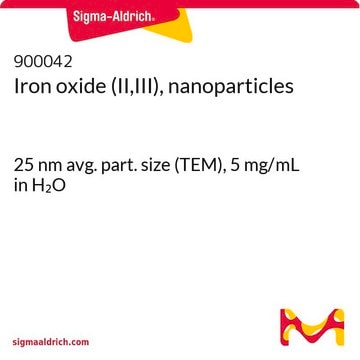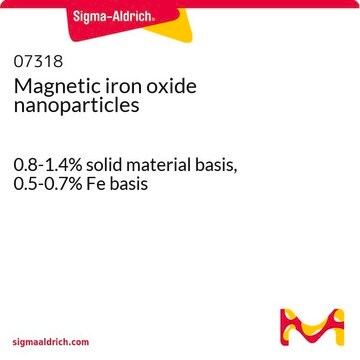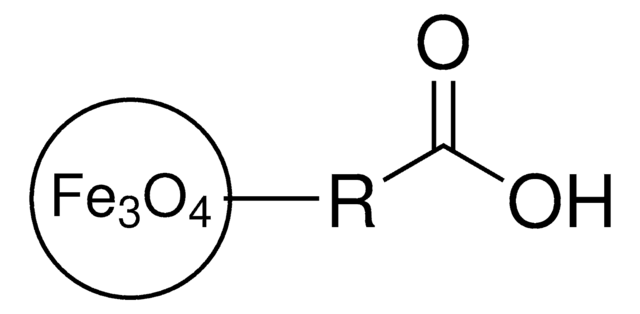725366
Eisenoxid(II,III), magnetische Nanopartikel -Lösung
20 nm avg. part. size, 5 mg/mL in H2O
Synonym(e):
Magnetische Eisenoxid Nanokristalle, Magnetit, Superparamagnetische Eisenoxid Nanopartikel
About This Item
Empfohlene Produkte
Form
dispersion
nanoparticles
Konzentration
5 mg/mL in H2O
Magnetisierung
>20 emu/g, at 4500Oe
Partikelgröße
18-22 nm
Durchschnittliche Teilgröße
20 nm
Dichte
1.00 g/mL at 25 °C
SMILES String
O=[Fe].O=[Fe]O[Fe]=O
InChI
1S/3Fe.4O
InChIKey
SZVJSHCCFOBDDC-UHFFFAOYSA-N
Suchen Sie nach ähnlichen Produkten? Aufrufen Leitfaden zum Produktvergleich
Verwandte Kategorien
Allgemeine Beschreibung
Anwendung
- Magnetic iron oxide nanoparticle (IONP) synthesis to applications: present and future: This report outlines the co-precipitation synthesis of magnetite nanoparticles using Fe(II) and Fe(III) solutions and discusses their future applications (N Ajinkya et al., 2020).
- Surface modification of magnetic iron oxide nanoparticles: Explores the surface engineering of iron oxide nanoparticles (IONPs) to enhance their functionality for various applications (N Zhu et al., 2018).
- Recent advances on iron oxide magnetic nanoparticles as sorbents of organic pollutants in water and wastewater treatment: Discusses the use of iron oxide magnetic nanoparticles in removing organic pollutants from water, highlighting the synthesis of core-shell magnetic nanoparticles (AM Gutierrez et al., 2017).
- Potential toxicity of iron oxide magnetic nanoparticles: Reviews the potential toxic effects of iron oxide magnetic nanoparticles, emphasizing their stability, biocompatibility, and size control (N Malhotra et al., 2020).
- Co-precipitation in aqueous solution synthesis of magnetite nanoparticles using iron (III) salts as precursors: Details the synthesis process of iron oxide nanocrystals and their potential applications in various fields (MI Khalil, 2015).
Lagerklassenschlüssel
12 - Non Combustible Liquids
WGK
nwg
Flammpunkt (°F)
Not applicable
Flammpunkt (°C)
Not applicable
Analysenzertifikate (COA)
Suchen Sie nach Analysenzertifikate (COA), indem Sie die Lot-/Chargennummer des Produkts eingeben. Lot- und Chargennummern sind auf dem Produktetikett hinter den Wörtern ‘Lot’ oder ‘Batch’ (Lot oder Charge) zu finden.
Besitzen Sie dieses Produkt bereits?
In der Dokumentenbibliothek finden Sie die Dokumentation zu den Produkten, die Sie kürzlich erworben haben.
Kunden haben sich ebenfalls angesehen
Artikel
Professor Mitsuhiro Ebara provides insights on several types of smart nanofiber mesh systems that have been explored for different drug delivery purposes.
Professor Hui Mao explores the use of superparamagnetic iron oxide nanoparticles (INOPs) that offer an alternate contrast-enhancing mechanism.
Prof. Yadong Yin discusses various synthesis methods of magnetite nanocrystals and their applications in different fields.
Unser Team von Wissenschaftlern verfügt über Erfahrung in allen Forschungsbereichen einschließlich Life Science, Materialwissenschaften, chemischer Synthese, Chromatographie, Analytik und vielen mehr..
Setzen Sie sich mit dem technischen Dienst in Verbindung.




